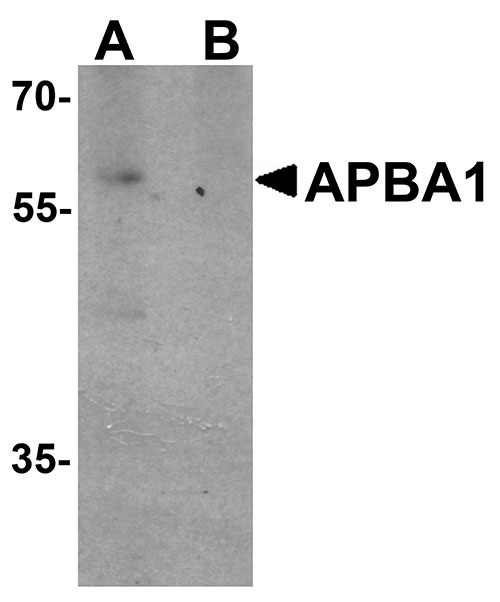APBA1 Antibody
- 产品详情
- 实验流程
- 背景知识
Application
| WB, IF, E |
|---|---|
| Primary Accession | Q02410 |
| Other Accession | NP_001154, 22035548 |
| Reactivity | Human, Mouse, Rat |
| Host | Rabbit |
| Clonality | Polyclonal |
| Isotype | IgG |
| Calculated MW | 92865 Da |
| Concentration (mg/ml) | 1 mg/mL |
| Conjugate | Unconjugated |
| Application Notes | APBA1 antibody can be used for detection of APBA1 by Western blot at 0.5 µg/mL. For immunofluorescence start at 20 µg/mL. |
| Gene ID | 320 |
|---|---|
| Other Names | Amyloid beta A4 precursor protein-binding family A member 1, Adapter protein X11alpha, Neuron-specific X11 protein, Neuronal Munc18-1-interacting protein 1, Mint-1, APBA1, MINT1, X11 |
| Target/Specificity | APBA1; At least two alternatively spliced isoforms are known to exist; this antibody will detect both isoforms. This antibody is predicted to not cross-react with other APBA proteins. |
| Reconstitution & Storage | APBA1 antibody can be stored at 4℃ for three months and -20℃, stable for up to one year. As with all antibodies care should be taken to avoid repeated freeze thaw cycles. Antibodies should not be exposed to prolonged high temperatures. |
| Precautions | APBA1 Antibody is for research use only and not for use in diagnostic or therapeutic procedures. |
| Name | APBA1 |
|---|---|
| Synonyms | MINT1, X11 |
| Function | Putative function in synaptic vesicle exocytosis by binding to Munc18-1, an essential component of the synaptic vesicle exocytotic machinery. May modulate processing of the amyloid-beta precursor protein (APP) and hence formation of APP-beta. Component of the LIN-10- LIN-2-LIN-7 complex, which associates with the motor protein KIF17 to transport vesicles containing N-methyl-D-aspartate (NMDA) receptor subunit NR2B along microtubules (By similarity). |
| Cellular Location | Cytoplasm. Cytoplasm, perinuclear region. Nucleus. Note=Only about 5% of the protein is located in the nucleus |
| Tissue Location | Brain and spinal cord. Isoform 2 is expressed in testis and brain, but not detected in lung, liver or spleen |
For Research Use Only. Not For Use In Diagnostic Procedures.
Provided below are standard protocols that you may find useful for product applications.
BACKGROUND
APBA1 Antibody: The Amyloid beta 4 (A4) precursor protein-binding family A member 1 (APBA1) is a member of the X11 protein family and a neuronal adapter protein that interacts with the Alzheimer's disease amyloid precursor protein (APP). APBA1 stabilizes APP and inhibits production of proteolytic APP fragments including the Aβ peptide that is deposited in the brains of Alzheimer's disease patients. It is thought to be involved in signal transduction processes and is a putative vesicular trafficking protein in the brain that can form a complex with the potential to couple synaptic vesicle exocytosis to neuronal cell adhesion. APBA1 can also bind to CASK, a multidomain scaffolding protein involved in brain development and synapse formation.
REFERENCES
Borg JP, Ooi J, Levy E, et al. The phosphotyrosine interaction domains of X11 and FE65 bind to distinct sites on the YENPTY motif of amyloid precursor protein. Mol. Cell. Biol. 1996; 16:6229-41.
Mueller HT, Borg JP, Margolis B, et al. Modulation of amyloid precursor protein metabolism by X11alpha/Mint1. A deletion analysis of protein-protein interaction domains. J. Biol. Chem. 2000; 275:39302-6.
Maximov A, Sudhof TC, and Bezprozvanny I. Association of neuronal calcium channels with modular adaptor proteins. J. Biol. Chem. 1999; 274:24453-6
Stafford RL, Ear J, Knight MJ, et al. The molecular basis of the Caskin1 and Mint1 interaction with CASK. J. Mol. Biol. 2011; 412:3-13.
终于等到您。ABCEPTA(百远生物)抗体产品。
点击下方“我要评价 ”按钮提交您的反馈信息,您的反馈和评价是我们最宝贵的财富之一,
我们将在1-3个工作日内处理您的反馈信息。
如有疑问,联系:0512-88856768 tech-china@abcepta.com.























 癌症的基本特征包括细胞增殖、血管生成、迁移、凋亡逃避机制和细胞永生等。找到癌症发生过程中这些通路的关键标记物和对应的抗体用于检测至关重要。
癌症的基本特征包括细胞增殖、血管生成、迁移、凋亡逃避机制和细胞永生等。找到癌症发生过程中这些通路的关键标记物和对应的抗体用于检测至关重要。 为您推荐一个泛素化位点预测神器——泛素化分析工具,可以为您的蛋白的泛素化位点作出预测和评分。
为您推荐一个泛素化位点预测神器——泛素化分析工具,可以为您的蛋白的泛素化位点作出预测和评分。 细胞自噬受体图形绘图工具为你的蛋白的细胞受体结合位点作出预测和评分,识别结合到自噬通路中的蛋白是非常重要的,便于让我们理解自噬在正常生理、病理过程中的作用,如发育、细胞分化、神经退化性疾病、压力条件下、感染和癌症。
细胞自噬受体图形绘图工具为你的蛋白的细胞受体结合位点作出预测和评分,识别结合到自噬通路中的蛋白是非常重要的,便于让我们理解自噬在正常生理、病理过程中的作用,如发育、细胞分化、神经退化性疾病、压力条件下、感染和癌症。







